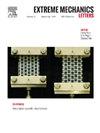Size-dependent strengthening in nanowires: The roles of adatom diffusion and surface curvature on surface dislocation nucleation
IF 4.3
3区 工程技术
Q2 MATERIALS SCIENCE, MULTIDISCIPLINARY
引用次数: 0
Abstract
Understanding the factors governing incipient dislocation nucleation in nanoscale solids is crucial for predicting their mechanical strength and plasticity. While previous experimental studies of surface dislocation nucleation in metal nanowires have observed a strong nonlinear size effect, commonly referred to as “smaller is stronger”, the atomistic origins of this phenomenon remain unresolved. In this study, we investigate the hypothesis that surface curvature, in conjunction with surface adatom diffusion, can have a significant effect on size-dependent strengthening in metal nanowires. The hypothesis is supported by transmission electron microscopy images that reveal a definitive correlation between edge sharpness and nanowire diameter, with smaller diameters exhibiting more blunted edges. To do so, we develop a nucleation-based Kinetic Monte Carlo model that incorporates activation energy barriers for surface dislocation nucleation that are surface-curvature and adatom dependent. The model reveals that the activation energy reduction caused by adatoms is highly sensitive to the nanowire surface curvature, with blunted edges leading to higher activation energy for dislocation nucleation. Therefore, our model and results suggest that size-dependent surface curvature, in conjunction with the role of diffusing adatoms in assisting surface dislocation nucleation, can have a significant effect on size-dependent strengthening in metal nanowires.
纳米线的尺寸依赖性强化:附原子扩散和表面曲率对表面位错成核的作用
了解纳米级固体中早期位错成核的影响因素对于预测其机械强度和塑性至关重要。虽然先前对金属纳米线表面位错成核的实验研究已经观察到强烈的非线性尺寸效应,通常被称为“越小越强”,但这种现象的原子起源仍未解决。在本研究中,我们研究了表面曲率与表面吸附原子扩散对金属纳米线尺寸依赖性强化有显著影响的假设。该假设得到了透射电子显微镜图像的支持,该图像显示边缘锐度与纳米线直径之间存在明确的相关性,直径越小,边缘越钝。为此,我们开发了一种基于成核的动力学蒙特卡罗模型,该模型结合了表面位错成核的活化能垒,这些活化能垒与表面曲率和附着原子有关。模型表明,纳米线表面曲率对杂原子引起的活化能降低非常敏感,边缘钝化导致位错成核的活化能较高。因此,我们的模型和结果表明,与尺寸相关的表面曲率,以及扩散的附着原子在协助表面位错成核中的作用,可以对金属纳米线的尺寸相关强化产生显著影响。
本文章由计算机程序翻译,如有差异,请以英文原文为准。
求助全文
约1分钟内获得全文
求助全文
来源期刊

Extreme Mechanics Letters
Engineering-Mechanics of Materials
CiteScore
9.20
自引率
4.30%
发文量
179
审稿时长
45 days
期刊介绍:
Extreme Mechanics Letters (EML) enables rapid communication of research that highlights the role of mechanics in multi-disciplinary areas across materials science, physics, chemistry, biology, medicine and engineering. Emphasis is on the impact, depth and originality of new concepts, methods and observations at the forefront of applied sciences.
 求助内容:
求助内容: 应助结果提醒方式:
应助结果提醒方式:


